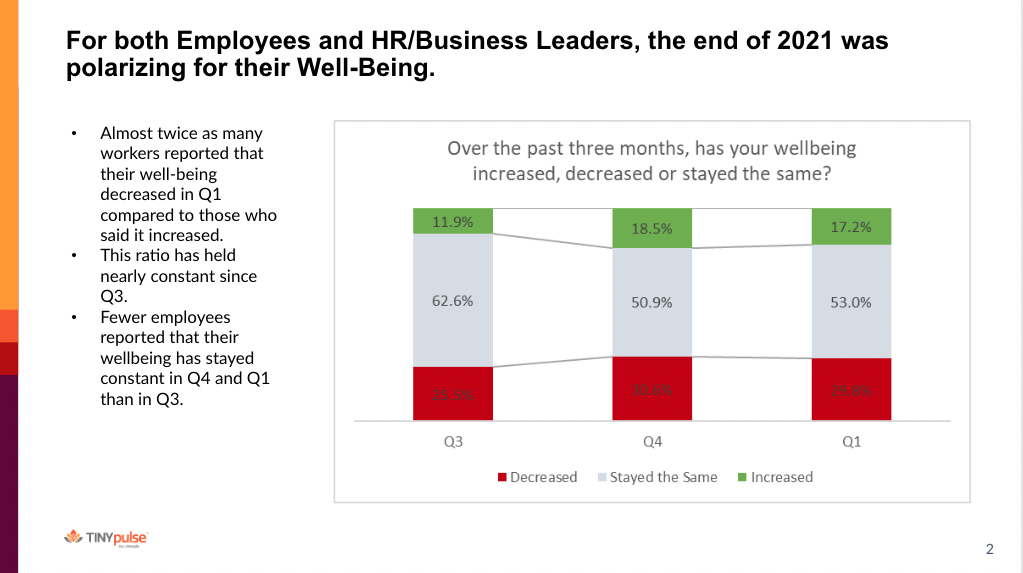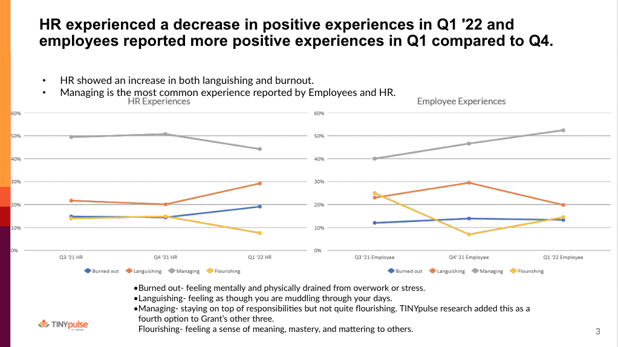5 Ways To Let Employees Flourish
Following the seismic impact of the pandemic, it is not hard to understand why employees’ general well-being, company culture, and workplace environments have all suffered a hit. The past two years have particularly taken a toll on everyone’s well-being and, more significantly, the well-being of employees globally.
One of its effects was the unprecedented changes in work nature, as work morphed either into full-fledged remote or hybrid patterns. The new paradigm forced significant changes in employees’ overall well-being.
Unprecedented, working from home and even hybrid work meant marked changes in employees’ work experience, leading to stress and social isolation as employees struggled to adjust accordingly. As if this was not enough, there was also the problem of immense workload, which was understandable as there was the pressing need to recoup output after a halt in work.
However, these problems were pronounced when the pandemic subsided, and work returned to the previous norm. Consequently, many workers reported high-stress levels and a decrease in well-being.
According to our recent survey, employees’ engagement dropped, showing a remarkable decline in their well-being. Well-being in this context implies a positive physical and mental experience in overall health.
This article looks to explain why employees’ well-being demands critical concern and how companies can respond to it, using insights backed by data.
Why is Employee Experience and Engagement a Concern?
Employees are critical to the effectiveness and productivity of a business. However, despite being tools for productivity, employees’ are human in themselves, and like everybody, they are vulnerable to emotional upturn and even mental health challenges.
This is why workers’ welfare requires more emphasis, especially considering the monumental changes experienced in the past two years. It suffices to note that a workplace environment threatening employees’ well-being will only result in a lack of motivation and a general decrease in the company’s productivity.
More so, bemoaning productivity in the workplace leaves us in a place of jeopardy. It is estimated that up to $550 million was lost to employees’ unproductivity in 2013 alone. But this has been even more atrocious in the past two years. The United States labor productivity dropped 7.5%, the most significant decline in worker output per hour since 1947.
This further shows an overall decrease in workers’ well-being owing to the hangovers from the pandemic. In an employee survey conducted last year and the early phases of this year, 29.8% of employees reported a sharp decline in their well-being
Another 53.0% admitted indifference, saying their well-being remained the same, while only 17.2% claimed their well-being experienced a rise. In subsequent months, as this image shows, there was a drastic reduction in employees’ well-being in the year’s second quarter.
However, there was a slight rise in workers’ well-being in the last quarter, but most admitted their well-being more or less remained the same.
Source: State of Employee Engagement Q1 2022
In the second image (below), our data reveals how workplaces have been primarily passive in responding to workers’ well-being. In the data, we categorized workers’ well-being into a spectrum: flourishing, managing, languishing, and burnout.
Feelings of flourishing are categorized as positives, while feelings of languishing, burnout, stress, and managing show indifference.
Source: State of Employee Engagement Q1 2022
Positive Feelings: Flourishing
Flourishing in the place of work refers to psychosocial functioning, where employees’ psychological needs are met by success in work delivery, a workplace environment that increases their sense of worth, competence, and the feeling of ‘I matter.’
From our data, the feeling of ‘flourishing’ in workers has been particularly wavering. From the third quarter of 2021 to Q1 2022, there has been a sharp regression in how employees experienced the feeling of “flourishing.”
According to the data, the ‘feeling’ of flourishing was somewhat on the rise in the previous year’s second quarter. It fell in the last quarter but rose in the first quarter of the following year. Compared to flourishing, the feeling of “managing” is most prevalent and has been rising since the previous year and even overlapping until the last year.
Negative Feelings: Languishing
Languishing represents the third yardstick on the well-being of the workers’ spectrum. Languishing in the workplace refers to a sense of inadequacy, making workers feel largely unmotivated and work as if they are “muddling through their days.”
Adam Grant defines it as lacking the desire to fit in “emotionally.” Languishing is a confluence between the extremes of burnout and managing. The feeling of languishing has been changing. It saw a significant rise in the last quarter of the previous year but has since been relatively steep.
Burnout is a state of physical or emotional exhaustion from being overworked or stressed. Burnout is a familiar feeling among employees, and it takes a particular degree of importance, especially against the backdrop of a pandemic and the radical changes accompanying it. However, fewer workers have only experienced burnout in the past years and even the first quarter of the current year.
Resources To Improve Employees’ Positive Experiences
Considering the data, it is evident that employee well-being has largely been stagnant. This is marked by a heightened state of ‘managing’ present in employees and the reduced number of employees experiencing the extremes, that is, flourishing and burnout. Since the previous year, fewer workers have reported a significant shift in their well-being.
Thus, heavy numbers have been essentially neutral. The apparent neutrality in workers’ experience can largely be explained by the lack of workplace resources that improve workers’ well-being. These resources range from physical and abstract features, including suitable workplace ergonomics, healthy foods, and meditation exercises.
1. Employee Listening Initiatives
Employee listening platforms represent one of the resources that influences the positive experience of employees. Employee listening platforms enable employees to share feedback in real-time surrounding emotional needs arising from work and personal issues.
At best, listening to employees can help leaders understand employees’ complex emotional complications such as grief and stress. Because of frequent workloads, employee listening channels are especially important as employees enjoy the luxury of communicating their thoughts and emotions to leaders and feel valued in the process.
2. Supplying Ergonomic Office Equipment
Workers’ well-being is not entirely tied to emotional or mental health concerns. Physical features like furniture and environment serenity play as much part. For example, proper office ergonomics make working more comfortable, which goes on to increase workplace productivity.
Employees work under perfect conditions by providing equipment that allows for the correct posture, and the risks of stress and burnout are lessened.
3. Encouraging Physical Activity
Employees’ fitness undoubtedly suffered a significant hit after spending months at home during the lockdown. Encouraging frequent movement breaks throughout the workday is a vital way companies can increase the fitness levels of their employees. But, this is not the only benefit of improved physical fitness of employees. Setting aside dedicated communications to encourage moving more often shows your workplace is committed to the physical and mental being of your employees.
Also, if you have the facility, group exercise classes induce a collaborative workplace atmosphere, conveying to employees that their physical and mental well-being are being considered. Regular gym membership also increases productivity as workers are fitter and more spirited to work.
4. Championing A Balanced Diet
Recently, studies have shown that nutrition has an astonishing effect on people’s physical and mental readiness. Unsurprisingly, employees have identified healthy eating as an indispensable part of their psychological and physical well-being. In addition, companies with a deliberate healthy eating mindset when supplying employees with meals, experience increased productivity and organizational efficiency.
Informing employees about the benefits of a balanced diet not only helps their workplace efficiency as it similarly helps their overall physical well-being. For example, recommending the consumption of high-proteins and vegetables implies more sustained energy and increased metabolism, assisting employees in increasing satisfaction and happiness.
5. Organizing Group Meditation
There’s no doubt that individual meditation relieves stress and helps in mental training. But there are more advantages to group meditation in the workplace. Significantly, group meditation encourages a collaborative culture among employees and strengthens bonds and relations with colleagues.
Unsurprisingly, companies initiating this program have reported tremendous progress in employee and company productivity. A typical example is Blackrock, an asset managing company with an estimated value of $4.8 trillion.
With over 1,400 employees worldwide and a bi-weekly meditation program, the company reported positive effects, including increased employee well-being and a general increase in productivity.
Also, a 2018 study by the University of California proved that meditation increases the ability to sustain attention. The by-product benefits of meditation aid the capacity to solve problems and think critically, essential qualities needed for a company’s growth.
Conclusion
How an employee feels at work is undoubtedly a critical part of organizational efficiency. As the data shows, a decrease in employee engagement implies a significant change in productivity, and a company risks spiraling into oblivion with less productivity.
In State of Employee Engagement reports covering 2021 and the first quarter of 2022, we discovered sharp changes in the well-being of workers, as many admitted indifference and others experienced a sharp decline.
We used yardsticks such as flourishing, managing, languishing, and burnout to rank employees’ well-being. But, of course, employees’ well-being never really dwelled on the extremes. Still, there’s a prevalent trend of managing, meaning workers’ overall health was largely neutral, not experiencing an increase or decrease.
This shows a scarcity of resources for creatively improving employee engagement. In light of this, we provided five prominent resources to enhance employee engagement and well-being in the workplace. Want to know more about these topics? Check our blog for more data-backed solutions on how to level up your organization.
Share this
You May Also Like
These Related Stories





.png?width=534&height=632&name=blog%20ad%20(1).png)
